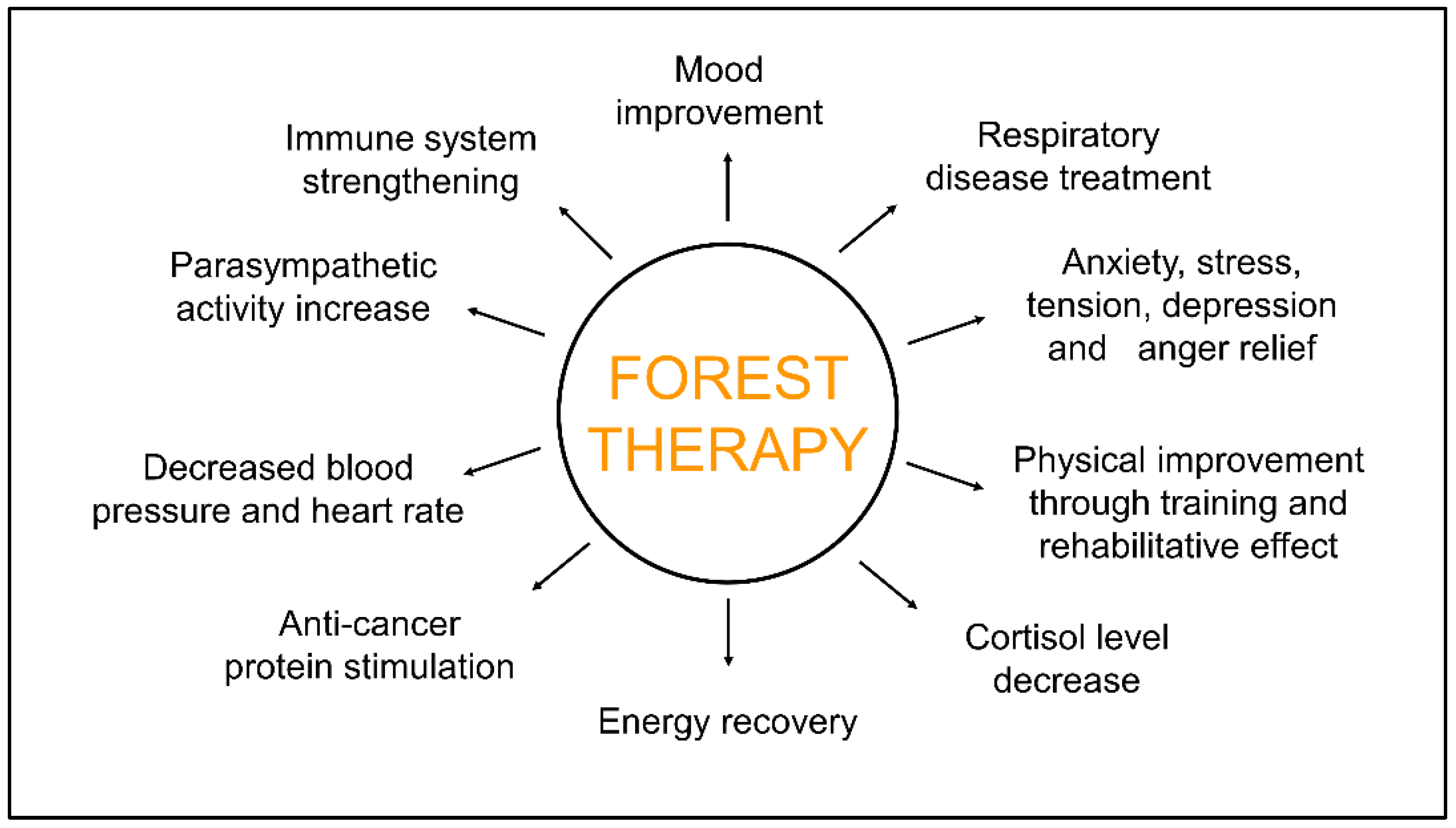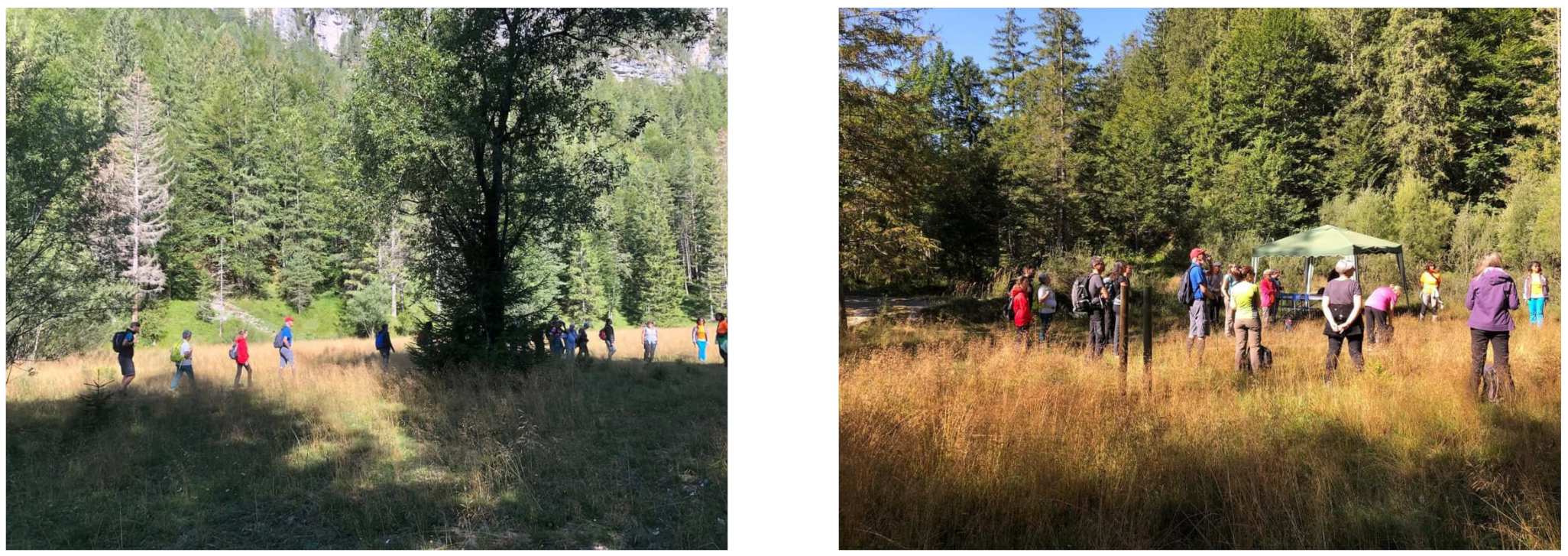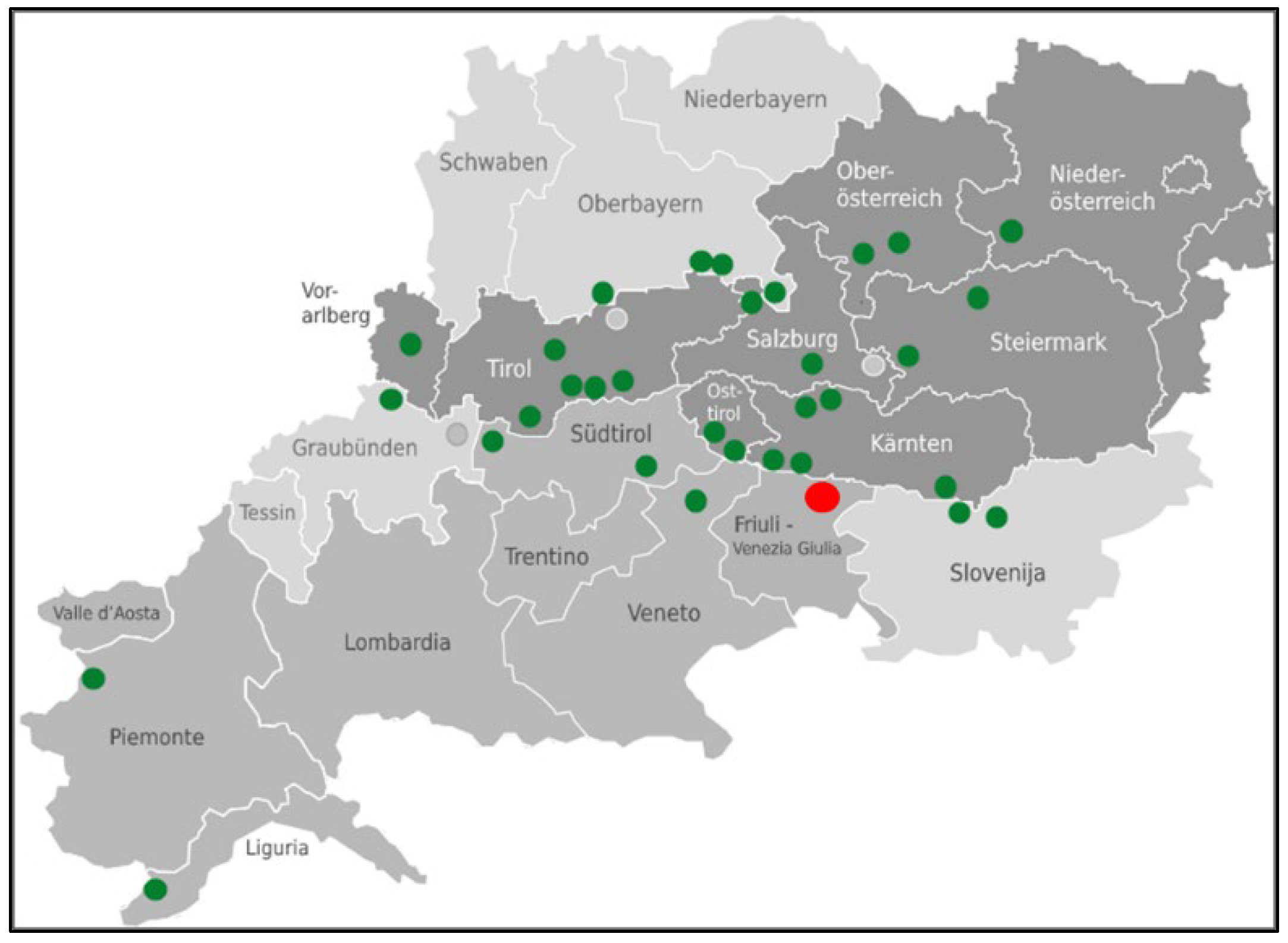Innovative Local Development Initiatives in the Eastern Alps: Forest Therapy, Land Consolidation Associations and Mountaineering Villages
Abstract
:1. Introduction
2. Materials and Methods
3. Case 1: Forest Therapy (FT)
4. Case 2: Land Consolidation Association (LCA)
5. Case 3: Mountaineering Villages (MVs)
6. Discussion and Conclusions
- Territorial innovation. The concept of innovation is not limited to inventions or changes never seen before (radical innovation), it also includes the ability to improve existing conditions to add or sustain value (incremental innovation) [57]. In this sense, we conceive territorial innovation as a reinterpretation of the human–nature relationships based on advances in knowledge and abilities over time as well as the ability to exploit emerging opportunities provided by new technologies [58,59,60,61]. Contemporary science-based forest therapy can be easily read as an advanced and improved version of 19th-century Alpine sanatoriums and their therapeutic practices. Similarly, land consolidation associations are the result of an adaptation to current societal needs and legal frameworks of traditional collective management institutions which played a central role in the conservation and exploitation of land assets in mountain areas. Finally, mountaineering villages provide an alternative to mass tourism, based on the respect for natural and cultural resources that characterize the Alpine region.
- New human–nature relationships. Development is not the static conservation of the original nature of places nor the transformation of the territory into a museum. It rather implies the acquisition of environmental knowledge to create virtuous relationships between communities and their environment and promote the adoption of good practices and regulations for the re-construction and care of spaces [14,62]. In this regard, sustainable development triggers virtuous change through the involvement of the community in the whole process, from conception and planning to implementation.
- Participatory approach. Indeed, the involvement of the community is essential to supporting local development initiatives [63,64,65,66]. The locals are not only the recipients of development initiatives—they are primarily the protagonists and agents of change, the only ones with the ability to re-shape their own environment, their community and the underlying social and economic relationships. Their deep-rooted knowledge of their territory, coupled with constructive interaction with experts and enablers, is essential to bringing positive change.
Author Contributions
Funding
Data Availability Statement
Conflicts of Interest
References
- Cortese, A. Alcune riflessioni sullo spopolamento montano in Italia. Giornale Storia 2021, 35, 1–13. Available online: www.giornaledistoria.net (accessed on 1 March 2022).
- Bartaletti, F. Geografia e Cultura Delle Alpi; Franco Angeli: Milano, Italy, 2009. [Google Scholar]
- Bätzing, W. Le Alpi. Una Regione Unica al Centro Dell’europa; Bollati Boringhieri: Torino, Italy, 2005. [Google Scholar]
- Salsa, A. Il Tramonto Delle Identità Tradizionali. Spaesamento e Disagio Esistenziale Nelle Alpi; Priuli&Verlucca: Ivrea, Italy, 2007. [Google Scholar]
- Salsa, A. Spopolamento e Spaesamento nella Montagna Italiana. In La Causa Montana-Michele Gortani Geologo, Costituente, Senatore; Gaspari, O., Ed.; Club Alpino Italiano: Milano, Italy, 2017. [Google Scholar]
- Salsa, A. I Paesaggi Delle Alpi. Un Viaggio Nelle Terre Alte Tra Filosofia, Natura e Storia; Donzelli Editore: Roma, Italy, 2019. [Google Scholar]
- Varotto, M. Montagne di Mezzo. Una Nuova Geografia; Einaudi: Torino, Italy, 2020. [Google Scholar]
- Magnaghi, A. Il Progetto Locale. Verso la Coscienza di Luogo; Bollati Boringhieri: Torino, Italy, 2010. [Google Scholar]
- Eckerberg, K.; Bjärstig, T.; Zachrisson, A. Incentives for Collaborative Governance: Top-Down and Bottom-Up Initiatives in the Swedish Mountain Region. Mt. Res. Dev. 2015, 35, 289–298. [Google Scholar] [CrossRef] [Green Version]
- Dax, T.; Oedl-Wieser, T. Rural innovation activities as a means for changing development perspectives–An assessment of more than two decades of promoting LEADER initiatives across the European Union. Stud. Agric. Econ. 2016, 118, 30–37. [Google Scholar] [CrossRef] [Green Version]
- Dax, T.; Strahl, W.; Kirwan, J.; Maye, D. The Leader programme 2007–2013: Enabling or disabling social innovation and neo-endogenous development? Insights from Austria and Ireland. Eur. Urban Reg. Stud. 2016, 23, 56–68. [Google Scholar] [CrossRef]
- Bosworth, G.; Rizzo, F.; Marquardt, D.; Strijker, D.; Haartsen, T.; Aagaard Thuesen, A. Identifying social innovations in European local rural development initiatives. Innov. Eur. J. Soc. Sci. Res. 2016, 29, 440–459. [Google Scholar] [CrossRef]
- Nardone, G.; Sisto, R.; Lopolito, A. Social Capital in the LEADER Initiative: A methodological approach. J. Rural. Stud. 2009, 26, 63–72. [Google Scholar] [CrossRef]
- Navarro, F.A.; Woods, M.; Cejudo, E. The LEADER Initiative has been a Victim of Its Own Success. The Decline of the Bottom-Up Approach in Rural Development Programmes. The Cases of Wales and Andalusia. Sociol. Rural. 2016, 56, 270–288. [Google Scholar] [CrossRef]
- Yin, R.K. Case Study Research: Design and Methods, 3rd ed.; Sage: Thousand Oaks, CA, USA, 2003. [Google Scholar]
- Denzin, N. The Research Act; Prentice Hall: Englewood Cliffs, NJ, USA, 1984. [Google Scholar]
- Thomas, G. A typology for the case study in social science following a review of definition, discourse, and structure. Qual. Inq. 2011, 17, 511–521. [Google Scholar] [CrossRef]
- Stake, R. The Art of Case Research; Sage: Newbury Park, CA, USA, 1995. [Google Scholar]
- Forest Therapy Station in the Municipality of San Leonardo. Available online: www.stazioneterapiaforestale.it (accessed on 1 March 2022).
- Forest Therapy Station in the Municipality of San Leonardo. Available online: www.spiaggiadiffusa.it/stazione-di-terapia-forestale-valli-del-natisone (accessed on 1 March 2022).
- Forest Therapy Station in the Municipality of San Leonardo. Available online: www.forest-therapy-italy.org/chi-siamo-il-progetto-in-friuli-venezia-giulia (accessed on 1 March 2022).
- Municipality of Stregna. Available online: www.comune.stregna.ud.it/index.php?id=3740 (accessed on 1 March 2022).
- Asfo Erbezzo. Available online: https://asfoerbezzo.substack.com (accessed on 1 March 2022).
- Asfo Erbezzo. Available online: www.facebook.com/asfoerbezzo (accessed on 1 March 2022).
- Mountaineering Village of Paularo. Available online: https://eng.bergsteigerdoerfer.org/5500-1-mountaineering-village-Paularo.html (accessed on 1 March 2022).
- LoScarpone, notiziario del Club Alpino Italiano. Available online: www.loscarpone.cai.it/paularo-villaggio-alpinisti (accessed on 1 March 2022).
- Meridiani Montagne, Montagna.tv. Available online: www.montagna.tv/198623/paularo-primo-villaggio-degli-alpinisti-del-friuli-venezia-giulia (accessed on 1 March 2022).
- SiViaggia. Available online: https://siviaggia.it/borghi/paularo-villaggio-alpinisti-friuli-venezia-giulia/364191 (accessed on 1 March 2022).
- Cho, K.S.; Lim, Y.; Lee, K.; Lee, J.; Lee, J.H.; Lee, I.S. Terpenes from Forests and Human Health. Toxicol. Res. 2017, 33, 97–106. [Google Scholar] [CrossRef]
- Masyita, A.; Sari, R.M.; Astuti, A.D.; Yasir, B.; Rumata, N.R.; Emran, T.B.; Nainu, F.; Simal-Gandara, J. Terpenes and terpenoids as main bioactive compounds of essential oils, their roles in human health and potential application as natural food preservatives. Food Chem. X 2022, 13, 100217. [Google Scholar] [CrossRef]
- Tetali, S.D. Terpenes and isoprenoids: A wealth of compounds for global use. Planta 2019, 249, 1–8. [Google Scholar] [CrossRef] [PubMed]
- Hansen, M.M.; Jones, R.; Tocchini, K. Shinrin-yoku (forest bathing) and nature therapy: A state-of-the-art review. Int. J. Environ. Res. Public Health 2017, 14, 851. [Google Scholar] [CrossRef] [Green Version]
- Hartig, T.; Mitchell, R.; De Vries, S.; Frumkin, H. Nature and health. Annu. Rev. Public Health 2014, 35, 207–228. [Google Scholar] [CrossRef] [PubMed] [Green Version]
- Payne, M.D.; Delphinus, E. A Review of the Current Evidence for the Health Benefits Derived from Forest Bathing. Int. J. Health Wellness Soc. 2019, 9, 19–30. [Google Scholar] [CrossRef]
- Ohe, Y.; Ikei, H.; Song, C.; Miyazaki, Y. Evaluating the relaxation effects of emerging forest-therapy tourism: A multidisciplinary approach. Tour. Manag. 2017, 62, 322–334. [Google Scholar] [CrossRef]
- Stigsdotter, U.K.; Corazon, S.S.; Sidenius, U.; Kristiansen, J.; Grahn, P. It is not all bad for the grey city–A crossover study on physiological and psychological restoration in a forest and an urban environment. Health Place 2017, 46, 145–154. [Google Scholar] [CrossRef] [PubMed]
- Chen, J.S.; Prebensen, N.K. Nature Tourism (Contemporary Geographies of Leisure, Tourism and Mobility); Routledge: New York, NY, USA, 2017. [Google Scholar]
- Cho, T.H.; Lee, Y.H.; Kim, S.M. The economic spillover effects of forest therapy projects in Korea. J. Korean For. Soc. 2014, 103, 630–638. [Google Scholar] [CrossRef] [Green Version]
- Droli, M.; Gervasio Radivo, G.; Iseppi, L. Does the Establishment of a ‘Forest Therapy Station’ in a Low-Mountain Mixed HardWood Forest Make Sense? In New Metropolitan Perspectives. NMP 2020. Smart Innovation, Systems and Technologies; Bevilacqua, C., Calabrò, F., Della Spina, L., Eds.; Springer: Cham, Switzerland, 2021; Volume 178, pp. 67–69. [Google Scholar] [CrossRef]
- Droli, M.; Taverna, M.; Iseppi, L.; Chang, T.F.M. Enlightening Integration Opportunities among Ecosystem Services ‘Forest Therapy’ and Rural Communities. In Green Metamorphoses: Agriculture, Food, Ecology, Proceedings of the LV Conference of SIDEA Studies, Perugia, Italy, 13–15 September 2018; Torquati, B., Marchini, A., Eds.; Wageningen Academic Publishers: Wageningen, The Netherlands, 2020; pp. 345–351. [Google Scholar] [CrossRef]
- Millennium Ecosystem Assessment. Available online: www.millenniumassessment.org (accessed on 1 March 2022).
- Beltramo, R.; Rostagno, A.; Bonadonna, A. Land consolidation associations and the management of territories in harsh Italian environments: A review. Resources 2018, 7, 19. [Google Scholar] [CrossRef] [Green Version]
- Gatty, R. The consolidation of farming lands in France. Am. J. Agric. Econ. 1956, 38, 911–922. [Google Scholar] [CrossRef]
- Cavallero, A. L’Associazione fondiaria per rivitalizzare l’agricoltura in montagna. PieMonti 2013, 7, 25–28. [Google Scholar]
- Probo, M.; Cavallero, A.; Lonati, M. Gestione Associata Delle Superfici Agro-Pastorali del Comune di Pragelato (TO); Edizioni Disafa: Grugliasco, Italy, 2016. [Google Scholar]
- Bonadonna, A.; Rostagno, A.; Beltramo, R. Improving the Landscape and Tourism in Marginal Areas: The Case of Land Consolidation Associations in the North-West of Italy. Land 2020, 9, 175. [Google Scholar] [CrossRef]
- Crosetti, A. Abbandono dei Terreni Rurali e Associazionismo Fondiario-Percorsi e Sviluppi Normativi. In Mondi Montani da Governare; Louvin, R., Ed.; Aracne: Roma, Italy, 2017. [Google Scholar]
- Povellato, A.; Vanni, F. Nuovi strumenti per le politiche fondiarie. Banca della terra e associazioni fondiarie. Agriregionieuropa 2017, 49, 31. [Google Scholar]
- Bassi, I.; Carestiato, N. Common property organisations as actors in rural development: A case study of a mountain area in Italy. Int. J. Commons. 2016, 10, 363–386. [Google Scholar] [CrossRef] [Green Version]
- Wagner, K. Rural heritage in the Austrian rural development programme. Econ. Agric. 2011, 58, 67–72. [Google Scholar]
- Trček, U.; Koderman, M. The Role of Tourism in Sustainable Development of Mountainous Border Region—The Case of Bovec Municipality, Slovenia. In Nature, Tourism and Ethnicity as Drivers of (de) Marginalization; Pelc, S., Koderman, M., Eds.; Springer: Cham, Switzerland, 2018; pp. 93–107. [Google Scholar]
- Siegrist, D.; Gessner, S.; Ketterer Bonnelame, L. Naturnaher Tourismus. Qualitätsstandards für Sanftes Reisen in den Alpen. (Nature-oriented Tourism. Quality Standards for Gentle Travel in the Alps); Haupt Verlag: Bern, Switzerland, 2015. [Google Scholar]
- Alpine Convention. Available online: www.alpconv.org (accessed on 1 March 2022).
- Romeo, R.; Russo, L.; Parisi, F.; Notarianni, M.; Manuelli, S.; Carvao, S.; UNWTO. Mountain Tourism–Towards a More Sustainable Path; FAO: Rome, Italy, 2021. [Google Scholar] [CrossRef]
- Bassi, I.; Carzedda, M.; Iseppi, L.; Nassivera, F. Sustainable Development in the Alps: The Mountaineering Villages (Bergsteigerdörfer) Initiative. In New Metropolitan Perspectives. NMP 2020. Smart Innovation, Systems and Technologies; Bevilacqua, C., Calabrò, F., Della Spina, L., Eds.; Springer: Cham, Switzerland, 2021; pp. 21–30. [Google Scholar]
- Mountaineering Villages. Available online: www.bergsteigerdoerfer.org (accessed on 1 March 2022).
- Amponsah Odei, S.; Stejskal, J.; Prokop, V. Understanding territorial innovations in European regions: Insights from radical and incremental innovative firms. Reg. Sci. Policy Pract. 2021, 13, 1638–1660. [Google Scholar] [CrossRef]
- Guo, J.; Cui, L.; Sun, S.L.; Zou, B. How to innovate continuously? Conceptualizing generative capability. J. Innov. Knowl. 2022, 7, 100177. [Google Scholar] [CrossRef]
- Puertas Medina, R.M.; Martín Martín, J.M.; Guaita Martínez, J.M.; Serdeira Azevedo, P. Analysis of the role of innovation and efficiency in coastal destinations affected by tourism seasonality. J. Innov. Knowl. 2022, 7, 100163. [Google Scholar] [CrossRef]
- Seddighi, H.R.; Mathew, S. Innovation and regional development via the firm’s core competence: Some recent evidence from North East England. J. Innov. Knowl. 2020, 5, 219–227. [Google Scholar] [CrossRef]
- Taques, F.H.; López, M.G.; Basso, L.F.; Areal, N. Indicators used to measure service innovation and manufacturing innovation. J. Innov. Knowl. 2021, 6, 11–26. [Google Scholar] [CrossRef]
- Cason, D.; Nardelli, M. Il Monito Della Ninfea. Vaia, la Montagna, Il Limite; Bertelli Editori: Trento, Italy, 2020. [Google Scholar]
- Batini, F.; Capecchi, G. Strumenti di partecipazione. Metodi, Giochi e Attività Per L’empowerment Individuale e lo Sviluppo Locale; Erickson: Trento, Italy, 2005. [Google Scholar]
- Ciaffi, D.; Mela, A. La Partecipazione. Dimensioni, Spazi, Strumenti; Carocci: Roma, Italy, 2006. [Google Scholar]
- Scarpelli, L. Organizzazione del Territorio e Governance Multilivello; Patron: Bologna, Italy, 2009. [Google Scholar]
- Gupta, H.; Nishi, M.; Gasparatos, A. Community-based responses for tackling environmental and socio-economic change and impacts in mountain social-ecological systems. Ambio 2022, 51, 1123–1142. [Google Scholar] [CrossRef]




| Websites | Documents | Unstructured Interviews | |
|---|---|---|---|
| Case 1 FT | Forest therapy station in the municipality of San Leonardo, Italy [19,20,21] | Press review [20,21] | Interviews with people behind the project [19] 2 people were interviewed. |
| Case 2 LCA | Municipality of Stregna, Italy [22] Asfo Erbezzo [23,24] | Statute of Asfo Erbezzo Asfo Erbezzo overall strategy 2021–2026 Asfo Erbezzo chestnut-growing strategy 2021–2026 Meeting reports of the Asfo Erbezzo general strategy participatory process Meeting reports of the Asfo Erbezzo chestnut cultivation strategy participatory process | Interviews with the president and spokesman of Asfo Erbezzo. The latter is also the Mayor of the Municipality of Stregna. Member of the Council of the Municipality of Stregna 3 people were interviewed. |
| Case 3 MV | Mountaineering Village of Paularo, Italy [25] | Meeting reports of the MV working group. In the period 2019-2021, four formal meetings were held, in addition to informal meetings on one-off aspects. Press review [26,27,28] | Interviews with the Mayor of the Municipality of Paularo, the President and members of the Ravascletto CAI Section. 4 people were interviewed. |
Publisher’s Note: MDPI stays neutral with regard to jurisdictional claims in published maps and institutional affiliations. |
© 2022 by the authors. Licensee MDPI, Basel, Switzerland. This article is an open access article distributed under the terms and conditions of the Creative Commons Attribution (CC BY) license (https://creativecommons.org/licenses/by/4.0/).
Share and Cite
Bassi, I.; Carzedda, M.; Iseppi, L. Innovative Local Development Initiatives in the Eastern Alps: Forest Therapy, Land Consolidation Associations and Mountaineering Villages. Land 2022, 11, 874. https://doi.org/10.3390/land11060874
Bassi I, Carzedda M, Iseppi L. Innovative Local Development Initiatives in the Eastern Alps: Forest Therapy, Land Consolidation Associations and Mountaineering Villages. Land. 2022; 11(6):874. https://doi.org/10.3390/land11060874
Chicago/Turabian StyleBassi, Ivana, Matteo Carzedda, and Luca Iseppi. 2022. "Innovative Local Development Initiatives in the Eastern Alps: Forest Therapy, Land Consolidation Associations and Mountaineering Villages" Land 11, no. 6: 874. https://doi.org/10.3390/land11060874
APA StyleBassi, I., Carzedda, M., & Iseppi, L. (2022). Innovative Local Development Initiatives in the Eastern Alps: Forest Therapy, Land Consolidation Associations and Mountaineering Villages. Land, 11(6), 874. https://doi.org/10.3390/land11060874






